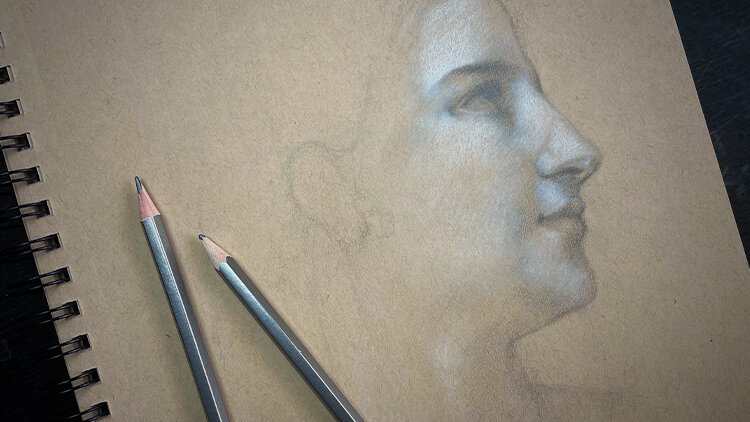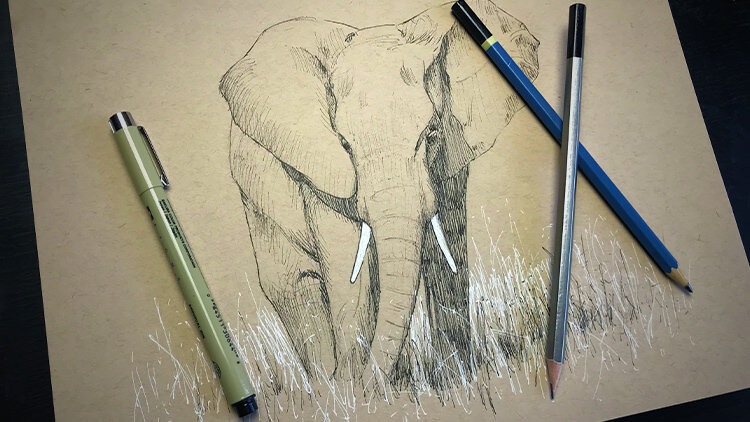3 Rules for Learning to Draw
You’re learning to draw and excited about the possibilities.
You have amazing ideas and can see them clearly in your mind.
But when you draw, it never turns out how you imagined. Some things just look off. This happens almost every time you draw. You feel discouraged and start to think “I’m just not good at this.”
Sound familiar?
Maybe you think you don’t have the talent for drawing, or that you’re too old to start learning now. Repeated frustration makes it more difficult for you to continue practicing and you lose motivation. Before you know it, you’ve given up on your dream of learning to draw.
But the real problem isn’t your skill level or amount of talent.
It’s the way you approach learning to draw.
If you want to truly improve your drawing skills, follow these three simple rules:
Don’t Quit
The most important rule when learning to draw is to not quit.
This might seem quite obvious but I’ve seen countless people over the years give up drawing because they felt they couldn’t do it, or weren’t talented enough. In order to avoid these feelings of quitting and giving up, it’s important to focus on why you started to learn to draw in the first place.
Ask yourself why you became interested in drawing. Why did you want to start learning?
Most likely it’s because:
you found joy in the process of drawing something
you want to be like other artists you admire
you’ve always wanted to learn and now you have the time to do it
The list is endless.
The point is: you want to make sure you always remember this purpose and if anything gets in the way - like overly-technical information that makes you feel overwhelmed and hopeless - you should ignore it for now.
Drop that information. It’s not important right now. Focus on other things. Things which keep you motivated to pick up the pencil and keep drawing.
Not quitting may be one of the hardest aspects of learning to draw and to follow through with but in the end, it’s worth all the challenges and effort you put into it.
One day you’ll be able to create your own masterpiece, but it won’t happen overnight.
This brings me to the next rule:
Be Realistic
When it comes to learning a new skill like drawing, you have to realize that this is a long process. No one on Earth has come out of the womb drawing like da Vinci - not even Leonardo himself! Keep this in mind.
That’s why it’s called “learning” to draw.
You have to be realistic and understand that it’s a learning process. And with any learning process, you’re going to make mistakes.
A lot of them.
Imagine learning a new language. Mistakes will always, without a doubt, be made but this is how you learn and make progress. You have to learn what not to do in order to find the path of what works.
You have to remember that mistakes don’t define you.
They are just simply mistakes.
Lessons to learn from.
Ways to grow.
You should fall in love with making mistakes so you can learn more and be open to making progress. It’s the only way forward. So accept and embrace it.
You’re going to make crappy drawings and sketches. We all do. Even after over 25 years of drawing, I still do as well.
I don’t like making crappy drawings, but I know if I practice more, stay patient, and keep drawing - I can improve my future drawings.
Remember this when you feel like you want to give up just because you made a mistake.
It’s part of the process of learning.
Speaking of the process, let’s get into the last rule.
Enjoy the Process
When I was young I drew a lot. I drew mostly cartoons and things from my mind, but I just drew a lot. I would copy VHS Disney covers, children’s books, and how to draw books. I had no idea what I would do with all those drawings or where I might end up one day.
All I knew was that I liked cartoons and I liked to draw them.
So that’s exactly what I did.
I focused all my energy on what I loved and enjoyed.
If something became too difficult to draw or I became frustrated, I just moved on and drew something I did enjoy. I always wanted to have fun when I drew. That’s the main reason why I was doing it.
As artists, once we get into our teens and a bit older, we begin to judge ourselves a lot. We have goals to reach and things we want to do. And when we don’t reach these goals quickly or see any progress at all, we give up. We move to something else to give us that quick satisfaction, especially in this era of social media and the internet.
But when I was younger, I didn’t really judge myself or my drawings. I just had fun. I fully enjoyed the process.
You should do your best to get back to this state of mind when you are learning to draw.
Draw things you enjoy and love. Have fun with it. If you’re not sure what you like to draw, then draw everything. You’ll eventually find out what bores you to death and what feels good to know.
You’ll also start to learn HOW you like to draw and WHAT you like to see in your drawings. This all takes time though and the important thing is to enjoy the process along the way.
Don’t worry so much about the destination, or reaching some slightly unrealistic goal.
Just enjoy the process.
If you enjoy what you’re doing, you’ll do it more and you’ll reach that goal before you know it anyway.
Use these rules to keep yourself on the path of learning the skill of drawing.
If you’re serious about learning to draw and leveling up your skills, check out The Intuitive Drawing Course. I made this course specifically to give you a method to follow and a path towards improving your drawings from the ground up.
Incorporating these 3 rules alongside the course are a game changer.
Thank you for reading.
— Brandon Schaefer

I am an artist, writer, and instructor. As a previous graphic designer for a healthcare management business, I now teach drawing, painting, and discovering your passion with art.
When You’re Ready, Here’s How I Can Help You:

Unlock your artistic potential and learn to draw with confidence using the Intuitive Drawing method. From your first sketch to creating realistic drawings and subjects.

